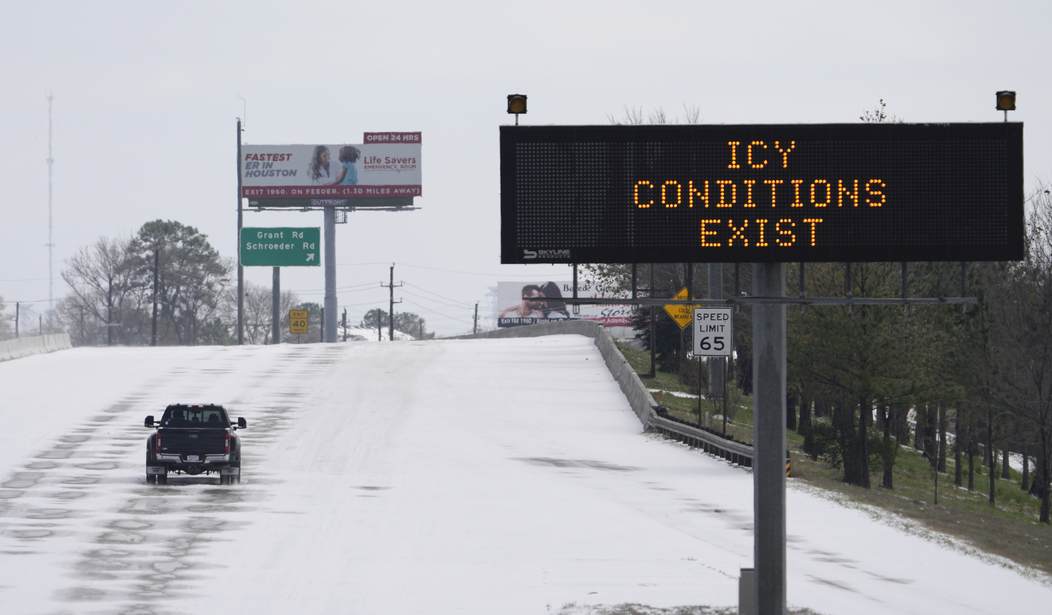It’s called the Electric Reliability Council of Texas (ERCOT), and it’s the organization that handles most of Texas’ electrical grid. And it failed horribly over the last few days as millions of Texans were left in frigid cold without power during this week’s freak weather occurrence that dipped the state into below freezing temperatures and dumped it in inches of snow.
Texas Attorney General Ken Paxton wants to launch an investigation into alleged mishandling of the situation by ERCOT, saying “ERCOT & other energy cos have slipped & fallen on their faces & it’s not the ice’s fault. They have left 3+ million homes w/o power for days, including my own,” in a tweet Wednesday. “What do they do in response? Jack up prices, go silent, make excuses, & play the blame game. It’s unacceptable!”
Abbott told KTRK Houston in an interview Tuesday evening that the power outages amount to “a total failure by ERCOT,” and called for reform of the organization to be an emergency item for the 2021 legislative session. He also said top ERCOT leadership should resign.
“Far too many Texans are without power and heat for their homes as our state faces freezing temperatures and severe winter weather,” Abbott said, NPR reported. “This is unacceptable.”
The spin started early from ERCOT’s defenders because ERCOT, responsible for about 90% of Texas’ energy, has spent the last year touting their foray into renewable energy — not just wind power, but solar, too. This glowing, self-congratulatory report on the magnificence of ERCOT’s renewable moves is from September 2020.
This year, the Electric Reliability Council of Texas or ERCOT, the electric grid that services about 90% of Texas electricity, is scheduled to add almost as much wind as it has in the past five years combined and almost triple its solar capacity. Yes, in 2020. The grid operator’s latest figures indicate that they expect, by the end of the year to have 31,069 MW of wind and 6,035 MW of solar on the system, up from 23,860 and 2,281 MW of wind and solar at the end of 2019.
…
Wind sometimes gets a bad rap because West Texas wind does tend to produce less energy during times of peak demand, but peak isn’t everything and it (all wind) still produces a lot of (20% of total) energy that keeps costs low. However, the new crop of coastal wind is a different story, strongly showing up when needed on peak. Solar shows up even stronger.
Clearly ERCOT didn’t plan for a once-in-a-lifetime winter storm that would play havoc with both wind (the turbines literally froze still in some cases) and days’ worth of pronounced icy precipitation and cloud cover.
And so, as mentioned, the spin began quickly in an effort to blame traditional energy sources instead of the recently sanctified renewables. Most notably with a report from the questionably reliable PolitiFact.
“Of the power shortfall that hit Texas, over 80% was due to problems at coal- and gas-fired plants,” PolitiFact reported.
Experts say traditional energy sources, including coal and natural gas, performed below expectations, while wind power actually performed above expectations.
“Main story continues to be the failure of thermal power plants — natural gas, coal, and nuclear plants — which ERCOT counts on to be there when needed. They’ve failed,” Princeton engineering professor Jesse Jenkins tweeted Tuesday. “Those of you who have heard that frozen wind turbines are to blame for this, think again. The extreme demand and thermal power plant outages are the principle cause.”
What they’re leaving out is that because Texas has been embracing condition-dependent renewable sources of energy — which require redundancy backup sources like natural gas, coal, and nuclear due to the aforementioned reliance of wind and solar on optimum weather conditions — when the renewables began to fail, the traditional energy had to fill the gap until they, too, began to experience problems. And it turns out some of those problems may have been because ERCOT had not winterized its system properly (but more on that in a minute). The Wall Street Journal spells it out:
Between 12 a.m. on Feb. 8 and Feb. 16, wind power plunged 93% while coal increased 47% and gas 450%, according to the EIA. Yet the renewable industry and its media mouthpieces are tarring gas, coal and nuclear because they didn’t operate at 100% of their expected potential during the Arctic blast even though wind turbines failed nearly 100%.
The policy point here is that an electricity grid that depends increasingly on subsidized but unreliable wind and solar needs baseload power to weather surges in demand. Natural gas is crucial but it also isn’t as reliable as nuclear and coal power.
Politicians and regulators don’t want to admit this because they have been taking nuclear and coal plants offline to please the lords of climate change. But the public pays the price when blackouts occur because climate obeisance has made the grid too fragile. We’ve warned about this for years, and here we are.
But the best evidence that ERCOT should be investigated comes with a report indicating that the small fraction of Texas not serviced by ERCOT seems to have had few outages at all. And it would appear it’s because they took the time to weatherize their systems following a 2011 winter storm that hit the state.
After the 2011 winter freeze, El Paso Electric, on the Western Interconnect grid, spent heavily to “winterize our equipment and facilities so they could stand minus-10 degree weather for a sustained period of time,” Eddie Gutierrez, an El Paso Electric spokesman, told KHOU. So this year, “we had about three thousand people that were out during this period, a thousand of them had outages that were less than five minutes.”
On the other side of Texas, near the Louisiana border, the city of Beaumont also appears to have weather the storm without massive outages. Entergy, which powers Beaumont on the Eastern Interconnect grid, told KHOU it also winterized its infrastructure after the 2011 storm. Weatherizing power generation and extraction equipment is voluntary in Texas, though the state legislature will probably revisit that strategy when it dissects ERCOT this year.
ERCOT’s back-patting over its love-affair with shakily reliable energy production may be less of a worry than its potential unwillingness (an investigation will make that clear or debunk it altogether) to make sure that it did everything it could to at least give those iffy renewables a chance to work in bad weather.














Join the conversation as a VIP Member